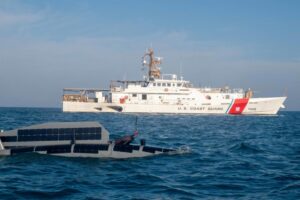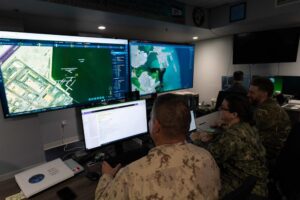The U.S. 5th Fleet completed the Digital Horizon three-week unmanned and artificial intelligence exercise event in Bahrain on Dec. 15.
The event started on Nov. 23 with 15 unmanned systems from 17 industry partners including
Aerovel, Shield AI, Easy Aerial, Elbit Systems, Exail, L3Harris Technologies [LHX], Marine Advanced Robotics, MARTAC, Ocean Aero, Open Ocean Robotics, Saildrone, Seasats and SeaTrac (Defense Daily, Nov. 23).

The exercise also included industry partners Accenture Federal Services, Big Bear AI and Silvus Technologies focusing on artificial intelligence and data integration while the aforementioned companies provided various kinds of unmanned vehicles, both in the air and on the sea surface.
The Navy underscored 10 of the unmanned systems had never operated in the Middle East previously.
This event was part of Task Force 59 (TF 59), the fleet’s effort to help speed up integration of unmanned technologies in that area of operation via various events and experiments, both unilateral and multilateral.
This Digital Horizons event had TF 59 lead the industry partners “during phased evolutions ashore and at sea to advance fleet efforts that will enhance regional maritime awareness.”
The service also noted during the event the task force used artificial intelligence to create an interface on one screen, dubbed a “single pane of glass.” This showed relevant data from various unmanned systems for the watchstanders in Task Force 59’s Robotics Operations Center.
“The pace of innovation throughout Digital Horizon was unbelievable. We pushed beyond technological boundaries and discovered new capabilities for maritime domain awareness to enhance our ability to see above, on and below the water,” Capt. Michael Brasseur, commander of Task Force 59, said in a statement.

The Navy also reiterated it launched an Aerovel Flexrotor small vertical take-off and landing unmanned aerial system (UAS) from the Coast Guard cutter USCGC Emlen Tunnel (WPC-1145), the first such launch of a UAV from a Coast Guard cutter via Task Force 59.
The fleet noted this launch enhanced the task force’s ability to create a mesh network for unmanned systems to relay imagery to command centers both at sea and ashore in a communication-denied environment.
“It has been an incredible opportunity to work with new systems and new partners to drive the innovation process forward for the U.S. Navy,” Lt. Jay Faylo, Task Force 59’s director of artificial intelligence, added.